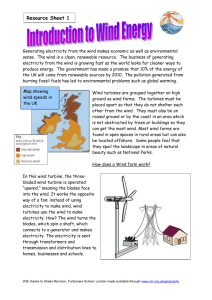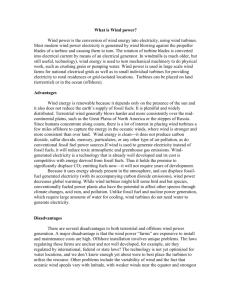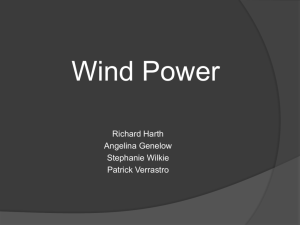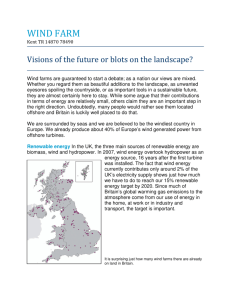Electricity from Hydropower
advertisement
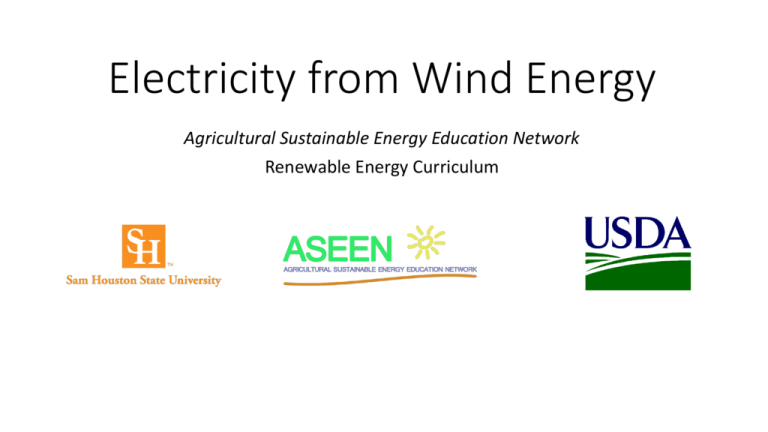
Electricity from Wind Energy Agricultural Sustainable Energy Education Network Renewable Energy Curriculum Introduction • Wind power captures the kinetic energy of the wind in our atmosphere and converts it into mechanical energy then into electrical energy or electricity. • People started using wind power centuries ago with windmills, which pumped water, ground grain, and did other work agricultural work. • Today's wind turbine is a highly evolved version of a windmill. Types of Wind Turbines Wind turbines are divided into Two General Types: • Vertical Axis • Horizontal Axis Horizontal Axis - A horizontal axis machine has its blades rotating on an axis parallel to the ground. Vertical Axis - A vertical axis machine has its blades rotating on an axis perpendicular to the ground. How Does a Wind Turbine Work? Wind turbines operate on a simple principle. The energy in the wind turns two or three blades around a rotor. The rotor is connected to the main shaft, which spins a generator to create electricity which is then sent to consumer’s transmission lines. Transmission & Distribution • Transmission lines are an essential part of the Electricity Grid. • They move electricity from where it is produced to where it is consumed. • The United States has more than 200,000 miles of high-voltage transmission lines. • These high-voltage transmission lines serve much like the interstate highway in facilitating electricity commerce and providing consumers with lower-cost electricity. Transmission & Distribution • The high-voltage transmission lines then connect to the smaller Distribution Power Lines. • These smaller Distribution Power Lines are the equivalent of smaller local roads on the Electricity Grid. • These smaller lines are the electrical lines that actually bring electricity into your farm or home. Grid-Tied Electrical Systems • If your farm or home is connected to the Electricity Grid, on windier days you may be able to "sell" excess power generated by your wind turbine to your utility. • If there are times when your turbine cannot generate all the power you need, you would buy power from the grid. • This concept is called "net metering" or "net billing." Stand-Alone Electrical Systems • In remote locations, Stand-Alone Electrical Systems that do not connect to the Electricity Grid can be cost effective for your farm or home. • Extending a power line to the electricity grid can cost from $15,000 to $50,000 per mile. • Stand-Alone systems can be used by people who live near the grid but wish to obtain independence from the power provider or demonstrate a commitment to non-polluting energy sources. Classes of Wind Turbines Wind turbines are divided into Two General Classes: • Small-Scale Wind Turbines have power ratings up to 100 kW and often transmit electricity directly to the owner’s farm or home. • Utility-Scale Wind Turbines have power rating greater than 1.5 MW and usually transmit electricity to the Electricity Grid. How Do Utility-Scale Wind Turbines Work? • A Utility-Scale wind turbine produces alternating current (AC). • The power is transmitted down the tower. • The power is then “stepped up” in voltage for connection to the Electricity Grid. • These Utility-Scale wind turbines are usually owned by a commercial electric company - not an individual. How Do Small Wind Turbines Work? • A rotor turns a shaft that is geared to turn a generator and generates the electricity. • A transmission line carries the generated electricity to the electrical devices that use it on your farm or in your home. • The balance of the system – other components such as the inverter and batteries – regulate the power according to the type of wind power system. Agricultural Applications • Stand-Alone Electrical Systems are needed more and more in the world of ranching and farming. • Remote locations need power to operate electric fencing, water pumps, lighting in stables and chicken sheds, or even underwater cameras at fish farms. • Stand-Alone Electrical Systems often have Small-Scale wind turbines and other equipment to meet the needs of ranchers and farmers and provide electricity at low-operating costs. Examples of Agricultural Applications How Much Energy Does the Wind Produce? • In 2013, wind energy provided 9.9% of the electricity used from the Electric Reliability Council of Texas’ Electricity Grid (ERCOT), the main Texas grid. • Texas wind farms now power the equivalent of over 3.3 million homes on an average day. • On May 2, 2013, wind energy generation hit a record 9,674 MW or 28% of ERCOT’s load. How Much Energy Can the Wind Produce? • According to data from the National Renewable Energy Laboratory, Texas’ onshore wind energy potential at 80 meters hub height is 1,901,530 MW. • This means that wind energy is capable of meeting more than 18 times the state’s current electricity needs. • Due to several geological and environmental factors, Texas has the best wind resource in the U.S. The bigger the Rotor, the more Wind Energy is captured! How Does Texas Stack Up? • • • Wind Energy generation: 5th Globally Natural gas prices: 15th Carbon Dioxide Emissions: 11th Natural Gas prices: 33rd ● Consumption per capita: 6th ● Most Used Source: ● Electricity Texas Has a State Policy! • Texas established a renewable portfolio standard (RPS) in 1999 and it was amended in 2005. The current RPS provisions require 5,880 MW of renewable energy by 2015. • The state also has a target of reaching 10,000 MW of renewable capacity by 2025, a target that the wind energy industry met in 2010. Developing New Wind Energy • Wind energy projects are developed by companies that seek out the areas with the strongest wind resource. • They also review critical factors like the access to land, the location of transmission lines, the ability to sell the electricity, and other significant development factors. • Once a site is identified, a developer will conduct wind resource assessment, site analysis and permitting, and transmission studies and can take several years. The Cost of New Wind Energy • Wind power is more stable than the changing prices of fossil fuel sources because it has no fuel cost. • Cost per unit includes construction cost of the turbine, transmission lines, return to investors, and other components that are averaged over the twenty year life of the equipment. • Wind's costs have dropped to the range of 5 to 6 cents per KW-hour recently... about 2 cents cheaper than coal-fired electricity. The Cost of Wind Energy Electricity Comparative Cost of Energy: How Wind Energy Stacks Up “Wind prices are extremely competitive right now, offering lower costs than other possible resources, like natural gas plants. These projects offer a great hedge against rising and often volatile fuel prices." David Sparby, president & CEO of Xcel Energy’s Northern States Power on July 16, 2013. Environmental Benefits of Wind Energy • Generating wind energy creates no emissions and uses virtually no water. • Water consumption savings from wind energy projects in Texas total more than 8.1 billion gallons of water per year. • The wind energy installed in Texas will avoid 22 million metric tons of carbon dioxide emissions annually, the equivalent of taking 3,900,000 cars off the road. Environmental Impact of Wind Energy • Wind turbines have the lowest global warming potential per unit of electrical generation. • Land uses such as agriculture and ranching are compatible with wind farms. • Prevention of wildlife fatalities affect the placement and operation of wind farms. • Peer-reviewed research does not support the claims of negative health effects. • Aesthetic aspects of wind turbines and resulting changes of the visual landscape are significant. Wind Energy in Texas Texas is the national leader in wind energy – with more installed capacity, more wind turbines and more jobs than any other state. •Installed Wind Capacity: 12,355 megawatts (MW) •Number of Wind Turbines: 7,772 turbines •Texas is home to 6 of the 10 largest wind farms in the U.S. •Wind Capacity Added in 2012: 1825.9 MW •Wind Capacity Added in 2011: 296.9 MW •Wind Capacity Under Construction at end of 2013: over 7,000 MW Economic Benefits of Wind Energy in Texas • Number of manufacturing facilities in Texas (2012): 45 • Total direct and indirect jobs support in 2012: 10,000. Texas ranks 1st for number of wind-related jobs. • Capital Invested: $23 billion dollars have been invested in Texas wind projects. Economic Benefits of Wind Energy in Texas Every 448 Wind Turbines equal: • 1 gigawatt of capacity • Pays private landowners $3.2 million in revenue • Pays $360 million in property taxes over 30 years • Stabilizes electric rates over the long term • Annual land lease payments: over $38 million to Ranchers and Farmers Wind Energy Production Worldwide • Worldwide there are now over two hundred thousand wind turbines operating with a total of 282,482 MW as of end 2012. • World wind generation capacity is doubling every three years. • As of the end of 2011, the Roscoe Wind Farm in Roscoe, Texas (781 MW) is the world's largest wind farm. Wind Energy Production Worldwide • Wind farms in South Australia generate half of the nation's energy needs. • Wind supplied 20.9 percent of Spain's electricity in 2013. • China is the leader in new wind energy installations. • Brazil is expected to double its wind power capacity in 2014. • India, South Africa, Vietnam, and Mexico are all prime markets. • Canada installed 23 new wind energy projects and ranks 5th globally for new installed capacity in 2013. What is the Future for Wind Energy? New Technology • Airborne Turbines access wind at altitudes near 1,000 feet - 85% of the US could have viable wind compared to 15% now. • Helium-filled structures reduce energy costs by up to 65% and installation time can be reduced from weeks to days. • Bladeless hollow poles filled with stacks of piezoelectric discs and electrodes sway in the wind and compress discs to generate current. What is the Future for Wind Energy? New Locations • Large wind turbines will be built on artificial islands with built-in hydroelectric battery storage. • Wind turbines will be constructed on floating foundations anchored at depths of up to 60m similar to oil rigs. • Wind turbines are also being built into big buildings and skyscrapers. • Integrated wind turbines will be built in urban environments disguised as trees. What is the Future for Wind Energy? New Support • Community-owned wind farms of 10,000MWh per year - enough to power around 30,000 homes will become common. • Manufacturers of utility-scale wind turbines will enter the small-scale market with innovative new designs. • The US Department of Energy aims to bring down costs of land-based wind energy by 18% and offshore wind energy by 63% by 2020. References • http://www.earthzine.org/2010/04/19/ten-steps-to-a-smarter-grid/ • http://www.ettdefenseinsight.com/tag/friends-of-maines-mountains-vboard-of-environmental-protection-wind-power-wind-farms-siting-friendsof-maines-mountains-maine-wind-energy-act-scenic-resources-mainesupreme-judicial-c/ • http://www.therenewableenergycentre.co.uk/wind-power/ • http://theenergycollective.com/eric-wesoff/468266/price-us-wind-powerall-time-low-25-cents-kilowatt-hour • http://cleantechnica.com/2014/08/23/cost-of-wind-energy-25-per-mwhand-falling/ • http://en.wikipedia.org/wiki/Energy_development • http://cleantechnica.com/2013/08/11/us-wind-power-prices-down-to-004-per-kwh/ • http://www.hi-vawt.com.tw/en/about_vaswt.html References • • • • • • http://www.eia.gov/electricity/annual/html/epa_08_04.html http://www.eia.gov/tools/faqs/faq.cfm?id=19&t=3 http://www.nsf.gov/news/news_summ.jsp?cntn_id=123998 http://www.bigge.com/news-and-events/windpower-press-releases.html http://countryoaksimages.com/tag/ranch-land/ http://science.howstuffworks.com/environmental/energy/future-windturbine.htm • http://www.windmeasurementinternational.com/wind-turbines/omturbines.php • http://www.greenchipstocks.com/articles/global-wind-energy/466 • http://www.planete-energies.com/en/the-energy-of-tomorrow/the-futurefor-current-energy-sources/renewable-energy/the-future-of-wind-energy276.html References • http://theenergycollective.com/eric-wesoff/468266/price-us-windpower-all-time-low-25-cents-kilowatt-hour • http://www.ucsusa.org/clean_energy/smart-energysolutions/increase-renewables/renewable-energy-electricitystandards-economic-benefits.html#.VE6STld7SWg • http://fresh-energy.org/2013/06/making-the-most-of-wind/ • http://en.wikipedia.org/wiki/Environmental_impact_of_wind_power • http://www.window.state.tx.us/specialrpt/energy/renewable/wind.p hp • http://www.awea.org/Resources/state.aspx?ItemNumber=5183 • http://www.renewableenergyworld.com/rea/news/article/2014/04/g lobal-wind-market-is-just-fine-thank-you • http://www.treehugger.com/wind-technology/future-wind-power-9cool-innovations.html


